Latest news about Bitcoin and all cryptocurrencies. Your daily crypto news habit.
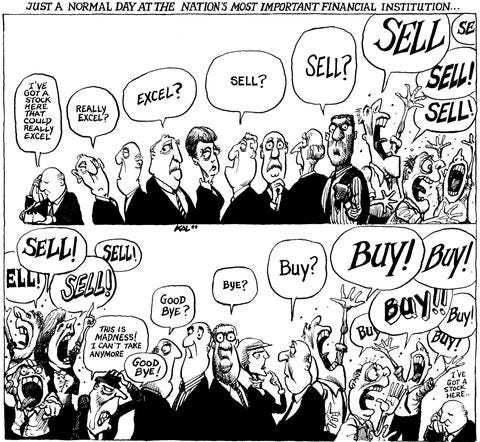
The dismantling of the ETH bull camp has been brutal:
> Over the past 30-days, ETH is -45% vs both USD and BTC, the 5th worst performance of the top-100 coins on onchainfx.com.
(The 4 coins worse than ETH are tiny, totalling just $500mn market cap vs ethereum’s current $25bn, 2050 market cap)
> Ethereum has fallen from market cap rank #2 to #4, overtaken by Stellar and Ripple (based on total 2050 supply, see onchainfx)
> A US judge has ruled a particular ICO to have violated securities laws.
> Even Vitalik-The-Saviour’s reliably rational musings are beginning to sound somewhat bearish ETH (!)
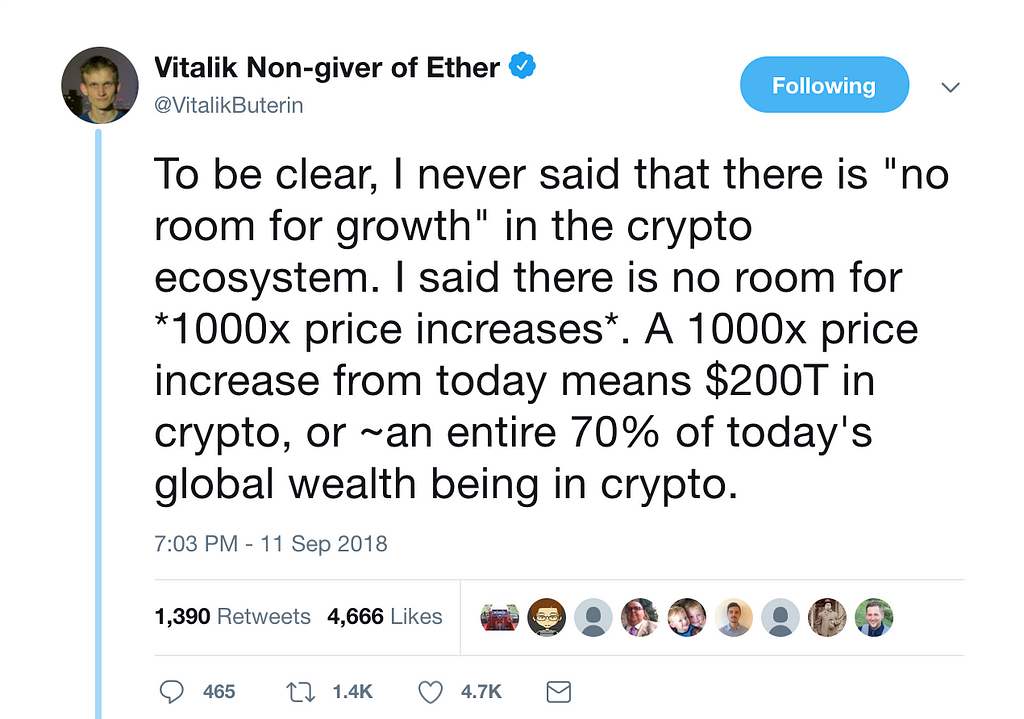 Vitalik: from smart contracts to investment advice. What can’t he do?!
Vitalik: from smart contracts to investment advice. What can’t he do?!
What’s driving this sell-off? Has the market suddenly changed its mind about the merits of Ethereum’s proposed ‘decentralisation’ and smart contracts? Is everyone now shifting towards the bitcoin maximalism ‘sound money’ view?
No. I believe ETH has experienced a liquidity and positioning driven ‘technical’ sell-off.
Further, I estimate that this may now be nearing its end.
Rationale:1) ETH has been underperforming other smart contract platform tokens
Ethereum can arguably be considered the highest quality smart contract platform (based on the age, developer ecosystem, market cap, hash power). This is an objective statement and different from the debate regarding whether Ethereum will become the ‘best’ platform or offer the highest investor return in a bullish scenario of broad decentralised application adoption.
If this is the case, given that crypto has been in a vicious bear market since the start of 2018, we can expect higher quality projects to outperform during a downturn. Capital that hasn’t already exited the asset class can be expected to ‘hide’ in safer projects, waiting for better times to reallocate to the racier, riskier projects with potentially juicer returns and wilder ideas.
However, this has not been the case this summer. Since the end of July, ETH has significantly underperformed the main smart contract competitors (EOS, Stellar, NEO, Cardano, NEM). This underperformance ranges from 10–125% see chart below.
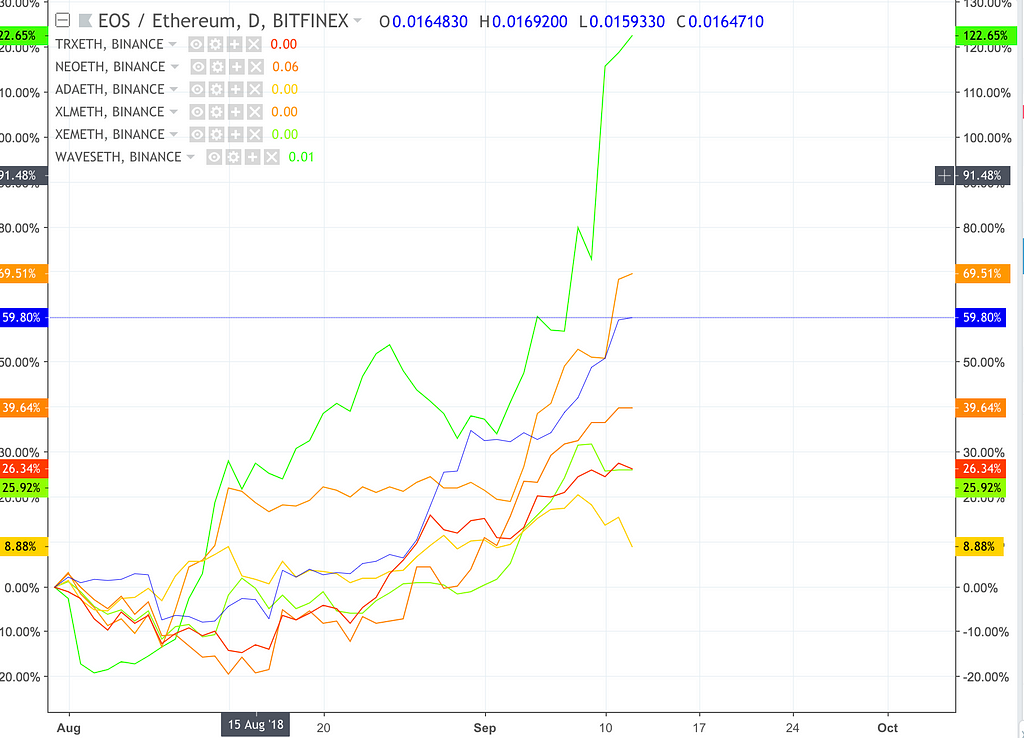 All smart contract platforms significantly outperform ETH since end of July
All smart contract platforms significantly outperform ETH since end of July
This dramatic underperformance by ETH is, in a strange way, reassuring. It’s saying that it’s an ETH specific issue rather than a broader disillusionment with the smart contract value proposition or the broader crypto asset class.
Theory 1: This is a ETH specific issue and not a crypto/smart contract/decentralsation re-evaluation
2) ICO treasuries are driving the selloff
Only Ethereum has conducted a meaningful amount of ICOs ($10bn and counting). Whilst this is a testament to the strength of its ecosystem, its also a short term liquidity issue to deal with as these ETH funds get converted into USD runway for the project teams.
The liquidation of these funds has been a very common and important point of discussion but one that is often misinterpreted. There is readily available data to track the progress of ICO treasury wallets as they turn their ETH into USD to fund their runways. See here or here.
Out of an approximate ICO total of 9.9mn ETH raised, it is estimated that 6.2mn (62%) has been sold.
However, many of these projects are small teams that will struggle to spend their huge ICO raise. In many cases, an anecdotal estimate of $10mn may be enough funding to last 1–2 years. With $10mn (USD!) or more in the bank, project treasurers may think twice before blindly converting their remaining ETH to USD.
Adjusting the ICO treasuries for this, it appears that 80% of required ETH selling has already been completed.
The assumptiom required in this analysis is that transfers out of the main treasury wallet are to exchanges (to be sold), rather than reshuffling of ETH funds between different wallets. If you have nore accurate data on this please get in touch! (h/t Sid Shekhar )
More so, everybody is aware of these treasuries being a forced seller. In my experience as a trader, knowing that there is a forced seller (or buyer) is a very lucrative piece of information. The panic that an ICO treasurer must be feeling as they sit on too much ETH, having raised possibly too much in the first place, having been previously confident about getting a better price to sell at…is easy to imagine. As they see ETH slip below $400, this panic is palpable. Other traders may even be inclined to piggyback this panic, and take the other side of the bet from these treasuries by shorting ETH. This is similar to how traders made a killing from the unwind of the implosion of the famous hedge fund, LTCM.
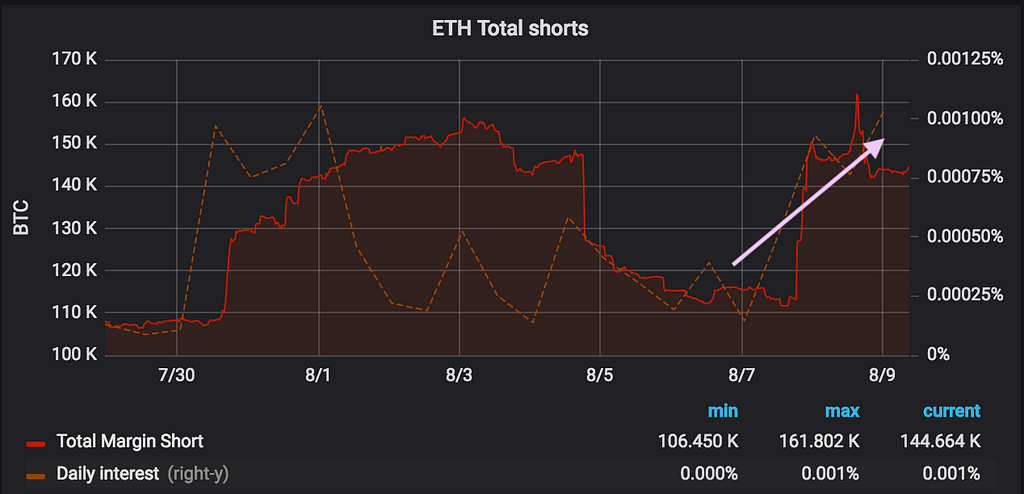 Sharks in the water: shorts have climbed in ETH whilst its price continues to fall
Sharks in the water: shorts have climbed in ETH whilst its price continues to fall
In equity trading, there is an anecdotal rule of thumb for dealing with trades that are disproportionately large eg rights offerings, block placements, index re-weights. For example, if there is a large amount of stock to sell and the event is known, by the time all the required volume has been traded the stock price will have already returned to normal. Buyers would have been happy to buy the last x% from the seller at a discount since the ‘end (of the selling) was in sight’.
Anecdotally, the market waits till 2/3 of the volume has been digested. It can be sooner if the market is more confident, or later if not.
The above data shows that have arrived at this stage with ETH. Or even beyond it, depending on your assumption for runway requirements.
Theory 2: The market may not wait till 100% of ETH have been liquidated. Enough ICO Treasury selling may have occurred for the market to potentially ignore the remaining.
3) ETH underperformance accelerated when it broke $400
What ties both of the above ideas together, is the fact that the underperformance of ETH really kicked in at the end of July. Right at the same time that ETH failed at the crucial psychological support level of $400. This is a level that has been tested several times over the past year and always resulted in significant trading volume.
It’s no coincidence that this underperformance accelerated at the same time as ETH broke $400. Instead, it’s very likely the direct impact of the panicking ICO treasurer selling.
We can very clearly see this panic as we break $400 through the huge increase in volume traded (see chart below). The volume traded of ETH has recently spiked to some of the highest levels seen. The ICO treasurers are pulling the eject cord.
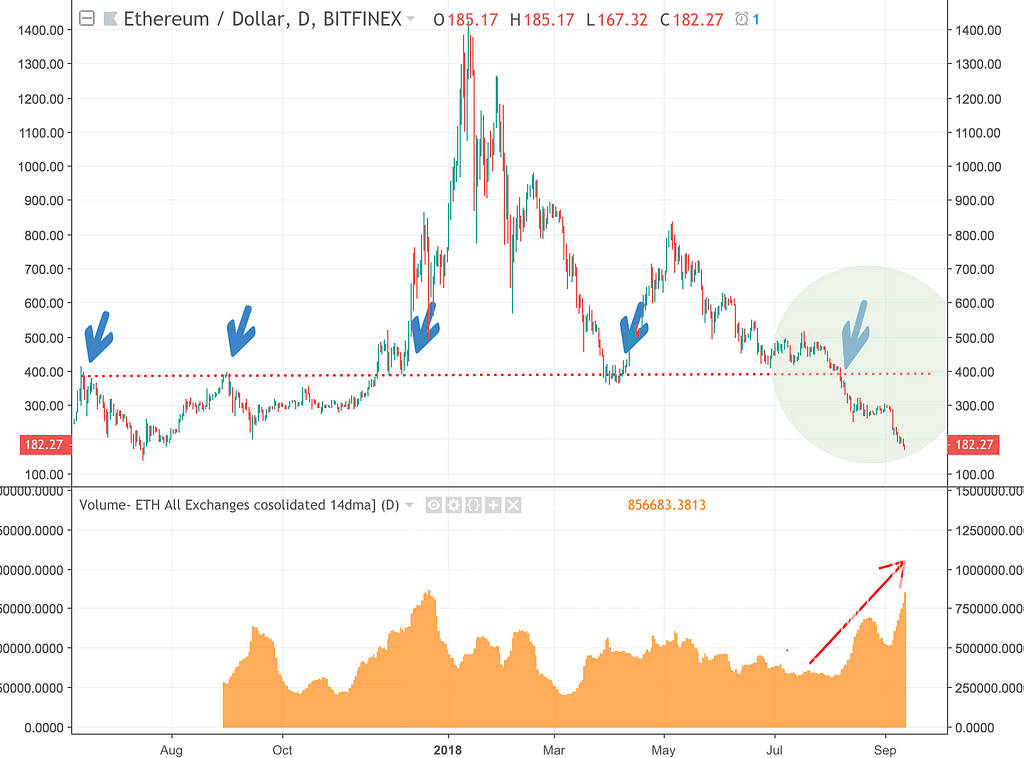 ETH testing the crucial $400 level and recently failing. Volume (and panic) spiking accordingly
ETH testing the crucial $400 level and recently failing. Volume (and panic) spiking accordingly
Supporting this theory of treasurer driven price narrative, I previously (correctly) predicted a small ‘Burning Man bounce’, see earlier email attached. I suggested that ICO treasurers were going to take a break from their relentless selling to hit the Playa in search of more fulfilling pursuits ;). Upon return, I expected this selling to continue, although not quite as aggressively as this!
Theory 3: Treasury panic selling is very visible. Panic normally signals that a certain move is almost over.
Conclusion
ETH has underperformed both smart contract and ‘sound money’ projects. This is not due to a shift in the prospects of Ethereum or its ecosystem. On the contrary, it is a direct result of the successful ICO capital raised by projects within its ecosystem. Estimates of remaining treasury holdings of ETH suggest that the end is in sight. In addition, there were very visible signs of panic as we broke the $400 price level.
The above combination of liquidity driven ‘technical’ selling pressure; credible explanation for the selling with a finish line in sight; visible panic and desperation; all add up to an attractive entry point for buying ETH.
What to do? The following is not investment advice but simply how I will be aiming to position my own portfolio.
Low risk: Sell and long holdings of other smart contract platforms and switch into long ETH instead. The other smart contract tokens have outperformed ETH and if the selloff is actually because no one likes crypto any more, these lower quality projects will not be spared.
Medium risk: Open a new position of short smart contract token XYZ vs. long ETH.
High risk: Buy ETH with fresh fiat. Or even with BTC.
Follow me on twitter for more trading insights @cryptobonsai
ETH: Time to Buy? was originally published in Hacker Noon on Medium, where people are continuing the conversation by highlighting and responding to this story.
Disclaimer
The views and opinions expressed in this article are solely those of the authors and do not reflect the views of Bitcoin Insider. Every investment and trading move involves risk - this is especially true for cryptocurrencies given their volatility. We strongly advise our readers to conduct their own research when making a decision.
